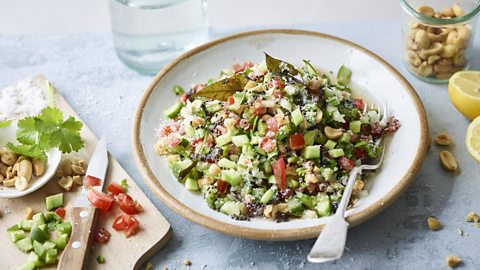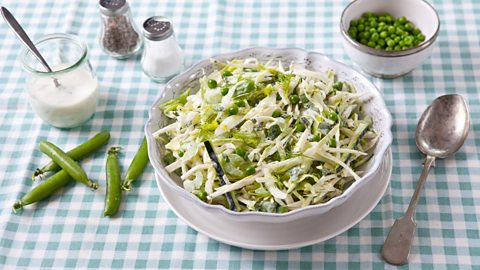Does cooking kill the vitamins in your food?
Vegetables are always more nutritious when eaten raw, right? In reality, while cooking can cause the loss of some vitamins and minerals, it can also make it easier for your body to absorb them. So which veg are best eaten raw ÔÇô and when should you get cooking?
Which veg are best eaten raw?
Cooking can reduce the nutritional content of veg. It can be a particular problem with vitamin C and the B vitamins and minerals like potassium, because they are water-soluble and so leach out into cooking water. That's fine in soups and stews because you consume the water, but it's a problem if you throw the water away. Kale, broccoli, cauliflower, cabbage, courgettes, spinach and peas have a good amount of these vitamins.
Heat also degrades these vitamins, so cook veg that are rich in them gently and in as little water as possible. Steaming, microwaving and stir frying are better options than boiling.
The good news is that many foods we usually eat raw are rich in vitamin C and the B vits (such as watercress, peppers, spinach, tomatoes and lettuce), so a balanced diet will provide you with plenty of them.
Chopped salad with peanuts
Chopped salads are flexible ÔÇô add any veg you like as long as it's cut up into small pieces.

Which veg are best eaten cooked?
Some veg are more nutritious when cooked because cooking breaks down their cells, which can allow you to absorb more of the nutrients even if some have leached out during cooking. This is true of beta-carotene (a precursor to vitamin A, found in carrots, butternut squash and sweet potatoes) and other carotenoids, such as lycopene, which is found in tomatoes.
Starches and proteins are easier to digest when cooked. If you're considering a raw food diet, keep in mind that some starchy foods such as potatoes can't be eaten raw, so including cooked foods increases the variety of your diet.
Cooking also improves the flavour of many veg, and if this makes you more likely to eat them it's worth losing some nutrients!
Get the low-down on which foods are best eaten raw or cooked in this quick video from vlogger Grace Victory.
Grace Victory video for │╔╚╦┐ý╩Í iWonder.
Hiya, Grace here. IÔÇÖm going to give you a quick rundown on what veg to eat raw and what to cook.
Studies show chopping, cooking and eating tomatoes with olive oil means you get more of the antioxidant lycopene, which can help protect cells from damage.
Also get a greater lycopene hit by cooking red peppers. High-heat cooking like chargrilling can cause carcinogens whenbrowning. But juicy vegetables like peppers are a good choice as they help keep the bad bits from forming.
You need to cook green beans, celery and carrots to get the most out of them.Beta-carotene (which converts to Vitamin A which helps cell growth) is higher in raw carrots, but you can absorb more of it when theyÔÇÖre cooked.
Celery and carrot can make a great base for soups and stews known as mirepoix.
Onion and garlic contain allicin ÔÇô a compound thought to be good for your immune system.Activate it through chopping, then resting the onion and garlic for ten minutes, before quickly cooking.
So what should you eat raw?
For maximum impact, eat raw kale, broccoli, and cauliflower.
Cooking, especially boiling cruciferous veg can ruin the availability of a compound thought to help in cancer prevention.
So crack out the salads ÔÇô trust me, kale tastes so much better marinated in olive oil and lemon juice!
Cress and cabbage are better for you raw! You can easily style these up in a simple salad or slaw.
ThereÔÇÖs one raw veg on the block that everyone loves ÔÇô the little green courgette! And thatÔÇÖs because they do so well in a spiraliser!
Do you eat raw peas and Brussels sprouts? Maybe itÔÇÖs time to start!
If you do, you can get more Vitamin B1, which helps you convert carbs into energy.
But some veg goes both ways.Raw spinach doesnÔÇÖt release as much calcium ÔÇô and when cooked, spinach loses Vitamin C, but it releases antioxidants, more calcium, magnesium and iron.
The main thing is, eat your vegetables. Loads of them ÔÇô cooked, raw, whatever. A balanced diet is the best diet.
Shredding your raw veg
Thinly shredding veg is a great way to make it taste delicious when raw. Use a spiraliser, a peeler, or just cut it into thin matchsticks with a knife.
Summery green coleslaw
Coleslaw is always a winner and this recipe from the Hairy Bikers celebrates summer veg.

Raw food diets
Raw food diets have gained popularity in recent years, with pretty pictures of smoothie bowls and naked treats all over social media. Like many extreme diets, it takes a kernel of truth and expands it into a whole lifestyle.
A raw food diet unsurprisingly involves eating only raw foods. But defining 'raw' is more complicated than you might expect. Proponents of a raw food diet define it as unprocessed and not reaching temperatures higher than 40-48C. The strictest versions exclude foods that have been refined, pasteurised, treated with pesticides or processed in any way.
Vegetable 'spaghetti'
Dust off your spiraliser to make pasta alternatives, like this simple courgetti recipe.

Heat is not the only way to cook food. Marinades (containing acids, such as vinegar or lemon juice) are a form of chemical cooking and also change the chemical structure of food.
Disadvantages of a raw food diet
- It's restrictive and can make eating out difficult.
- As the variety of foods eaten is limited, it can lack nutrients and energy. It is particularly difficult to get enough protein, vitamin B12 and iron on a strict raw food diet.
- It can be hard to know how to get the best from your ingredients. Some raw foods provide enough nutrients when eaten whole, while chopping and pur├ęeing others mean they can release more nutrients.
- Maximum nutrition doesnÔÇÖt always correlate with optimum flavour.
- Some foods are more nutritious when eaten cooked.
Advantages of a raw food diet
- ItÔÇÖs beneficial to eat some raw foods, such as fresh fruit and salads, because they contain higher levels of some vitamins.
- Raw food can be quick and simple to prepare.
Originally published August 2019